| Back to Back Issues Page |
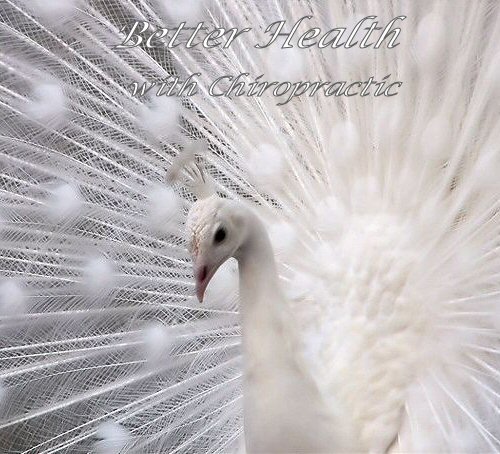 |
|
CHIROPRACTIC HELP #40: Ominous Lumbar Signs September 28, 2014 |
DearOminous Lumbar SignsGreetings again from Chiropractic Help.
This month we consider the many and varied features of lower back pain that we face in our clinics; these are situations that get us a little excited. Periodically, you will suffer an acute episode of lower back pain; if any of these ominous signs trouble you, then you'd better sit up and take notice. The surgeon awaits you. Sixty percent of the average chiropractor's day is taken up with treating the various conditions associated with lower back pain; and there are many of them. It could be a sacroiliac condition, mostly often a simple fixation, or sprain, but occasionally one of the diseases like ankylosing spondylitis that has a liking for the SIJ. An arthritic hip, too, causes a fixation in the sacroiliac joint; in fact, it's so jammed that it feels like concrete. One thing we're not sure of; does a chronically fixated SIJ lead on to a degenerative ball and socket, or is it the other way round. Personally, I believe both happen, but there's no certainty on the subject. The facet joints in the lumbar spine are a common cause of lower back pain too. I remember well the first time I tweaked my own back; up a ladder that started to slide sideways, my spine was forced sharply and violently into lateral flexion; ouch. Kemp's test is the definitive examination. A lumbar facet syndrome high in the lower back is the cause of a mysterious condition first named by a French orthopaedic surgeon by the name Maigne. It affects the superior cluneal nerves causing buttock and groin pain. As we age, particularly if there is an associated short leg and scoliosis, the facet joints become arthritic leading to the more difficult pinched nerve syndromes, frequently in the older person. Often it's in the middle to upper lumbar spine causing pain down the front of the leg. Slipped disc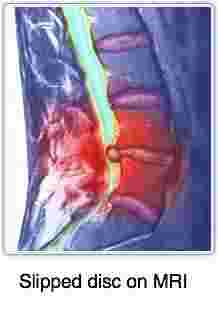 And then, of course, there are the many variations of slipped disc that cause debilitating lower back and leg pain. Interestingly, if that disc is reduced within a few days, unless there was a full sequestration, as it's called, not much loss of disc space results. Use this search function if you
want more information on the terms used on this page. For example, type "Maignes syndrome" into the space below.  Custom Search
Now, about those ominous lumbar signs; just what are the things that will get your chiropractor excited, and thus should be of concern to you too, of course? 1. Dejeurine's triad
Injury to the disc, when the inner bubble of shock absorbing gel ruptures through one or more layers of the surrounding washer, known as the annulus fibrosis, will cause pain on bearing down, as on the toilet, coughing and sneezing; and laughing too, perhaps. This is something that happens probably to every single one of us, periodically. You bend and twist, and lift something and, bingo, you feel something give in your back. It starts to swell and a few hours later, you go to the toilet, and you feel pain in the lower back, when you bear down. For the majority, these small sprains will resolve, if you are careful about bending and lifting for a few weeks, and do our lower back exercises; your chiropractor would, of course, like you to consult him! 2. Tingling and pain in the leg
Forgetting the 50 percent less pain rule, you get back into the deep end of the pool too quickly, back to the vacuum cleaner or gardening, and bingo, your non-complicated mild sprain suddenly ruptures further, and you begin to feel something ominous in the leg. Beware, this is now getting more difficult, and troubles may lie ahead. If it affects the lower lumbar discs, then you will feel the discomfort and perhaps pain initially in the back of the thigh; if it progresses, you will feel pain in the calf and ultimately the foot. This is the distribution of the sciatic nerve. In older folk, the mid to upper lumbar spine is often affected, irritating the femoral nerve, in which case the pain will likely be in the front of the thigh. 3. Antalgia
I call it the sign of Pisa. 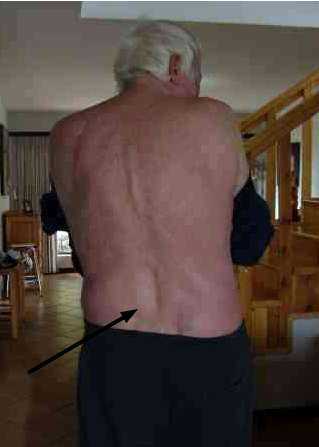 When you have lower back and/or leg pain, and you suddenly find yourself looking like a question mark, then beware; this is indeed an ominous sign. It's often the prelude to sudden onset of acute leg pain; in anatomical jargon, a progression from a relatively simple protrusion to a far more serious prolapse. The bulging disc is now interfering with the nerve root. 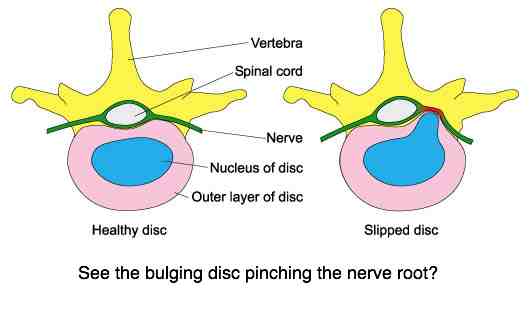 It's controversial, because research concludes that bed rest alone does not help back pain, but I insist that antalgic patients, those with the sign of Pisa, take what I call massaging bed rest; bed rest with specific exercises, and getting up every hour. And, of course, the chiropractic adjustment to reduce that bulging disc. 4. The crossed sign
Here you can see yours truly doing the Slump Test for Sciatica on the superb chiropractor who saved my bacon last year; more about that lower down. 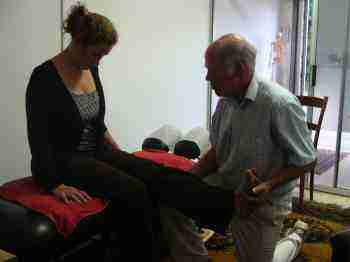 When you have a slipped disc if, when sitting, you straighten first one and then the other leg parallel to the ground, and it causes pain in the back, or tightness in the leg, it gives your chiropractor information about the bulge. When straightening the left leg, say, and it causes more pain on the right side of your back than raising the right leg, then beware; it's called the crossed sign of Fajersztajn. It's the sign of a medial disc herniation; far more medial discs end up in surgery than lateral discs. Oddly, because they respond far more quickly to the chiropractic adjustment than the lateral disc, but both take six weeks to heal. After a medial disc protrusion folk are inclined to think it was no big deal, don't do the exercises, stop treatment, and then re-injure the disc before it has healed. Then it goes down the leg and the surgeon starts getting excited. You don't want to get the surgeon excited. Your chiropractor will be angry too; not that s/he failed. You just didn't do what you were told. And now for the three most ominous lumbar signs, *: Really ominous lumbar signs5*. Crossed
sign to the opposite leg
When raising the opposite leg, it doesn't just cause pain in the back, but down the thigh and even calf, then you have a very large medial prolapse. You have left lower back pain; then a few days later you sneeze, say, and the pain starts going down the left leg. If raising the right leg, gives you pain in the left leg, this is a very serious sign. Get help and accept that you have to stop. Full stop. You are on the verge of surgery. Progressive numbness, weakness in the leg and loss of the reflex is the order of the day. 6*. Extension and lateral flexion causes pain in the leg
A personal anecdote. You hurt your back; in my own case, I lifted a very heavy patient on the chiropractic bench, and pulled her shoulder to the edge in preparation for a chiropractic adjustment, whilst I was bent and twisted. You feel something give in your back and a twinge of pain. Within the hour you find yourself stuck in a slightly flexed posture and possibily with the sign of Pisa too, leaning towards the opposite side: the postero lateral prolapse.
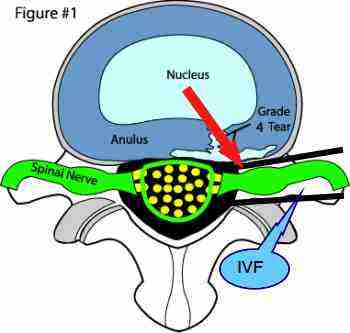 Notice the slight swelling on the green spinal nerve within the IVF; that's called the dorsal nerve root ganglion, filling a large part of the foramen. The rest is filled with fat which looks white on an MRI. 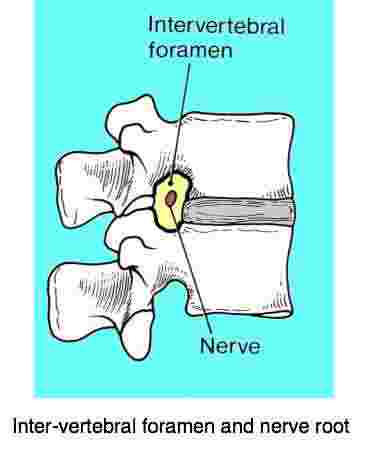 Suffice it to say, there is very little room in the foramen; any swelling of the disc and, in particular, any extrusion of disc material into the foramen immediately squeezes out the fat and presses on the nerve root ganglion. It's one of the most pain sensitive tissues in the body. PAIN. This nerve consists of two parts:
Usually only the sensory fibre is affected, resulting in tingling and pain in the leg. Sometimes the motor nerve root is also pinched, causing weakness in the leg. If the bubble of gel actually breaks off from the main nucleus pulposis, then the pain in the back subsides but your leg will be on fire. Perhaps you are lucky and still have a very sore back. 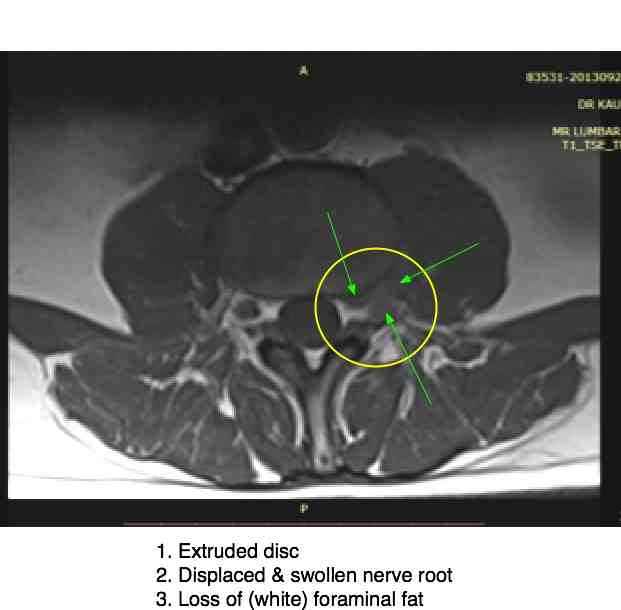 In my own particular case, the Femoral nerve was pinched. Severely; that night the pain in the back subsided completely, but I was groaning all night with a severe ache on the side of the hip, and radiating across the thigh and down the inner lower leg. Just medial to the knee, it remained numb for nearly six months. For the first time in my life I took anti-inflammatory tablets; they did ease the pain. The quad muscle became very weak and started to give on the stairs, and the inner lower leg went numb. Let's be honest; this is normally a job for the surgeon. I was lucky; I know about such things, what to do and what not to do, and my daughter is an extremely good chiropractor. Plus the radiologist who read the above MRI said:
There followed two weeks of rigorously following my very own slipped disc rules, ice packs, bed rest, no sitting and exercises every hour. Plus a chiropractic adjustment every day. One week of misery, followed by another week of partial misery; the severe pain was over within about 10 days and a gradual return to normality. It took about six months before I felt I could really trust my back again, dig in the garden, lift beehives, lug gliders about the airfield and do all the things I was used to. In short, if bending backwards and to the side of pain causes severe pain down your leg, but not in your back, follow the dictates of your chiropractor to the letter; and accept that s/he may not win. You have to travel by car (lie on the back seat) to get to the chiropractor; I could walk to the clinic. 7*. Cauda Equina Signs
If you lose the ability to urinate or defecate, then you need to be admitted immediately for catheterization; otherwise your bladder may rupture. Do not mess with seeing your chiropractor; this is definitely a job for a surgeon. The upside is that it's extremely rare; I recall only two cases in 35 years. 8*. Braggard's test
During the straight leg raise of Lasegue your doctor will dorsiflex your foot; pull your toes towards your head. If it reproduces the pain in the leg then it confirms a strong nerve impingement. Occasionally, dorsiflexing the foot whilst the leg is still lying on the examination couch reproduces the pain in the leg; it's a very serious sign. And if dorsiflexing either foot causes severe pain, then it's extremely complicated. Not to say that chiropractic can't help, but you will have to stop and doing everything right; so will your chiropractor. Summary of Ominous Lumbar Signs
Five percent of slipped discs end up under the knife; that means that 95% can be saved. See your chiropractor, but do take it seriously. That 5% have usually refused to follow the slipped disc rules, and pay the price. Accept that it takes a minimum of six weeks to heal, and you may need to see your chiropractor for that period; longer if you have any of those starred signs. With almost 400 pages, navigating your way around Chiropractic Help is difficult to say the least. Use that Search this site key in the navigation bar on your left to see if there is information on slipped disc rules, or knee arthritis, or foot pain; the virtues of olive oil and why butter is back; whatever you are interested in.
Are you taking too much medicationAs a profession, chiropractors are neither against taking medicine nor surgery; both have a very important place in the health regimen; having said that, medications taken chronically all have side effects. Even aspirin. 200,000 people die every year in the United States from the side effects of prescription drugs; could it be that you have become reliant on taking far too many drugs? And yet the USA doesn't lie in the gambit of the top healthiest forty nations; in fact, one of the reasons is all these drugs. If you are eating correctly, getting enough exercise and don't smoke then the norm is zero chronic medication; besides perhaps for blood pressure as you get older. If you are constipated then you can be sure you aren't eating properly; more about that hoary chestnut next month.

Autumn veggie gardenThe summer is rapidly passing in the northern hemisphere; hopefully you have some lettuce and spinach in the garden still; are still able to enjoy some pole beans.If you are in the milder south then you may still have time for a couple rows of radishes; definitely one of my favourite veggies. In really mild winters like where we live, broccoli, cabbage, spinach, lettuce and green peas are all the order of the day; we enjoy them every day.
Research in Spine"Spine" is the premier medical research journal on things pertaining to your back. In a recent publication, researchers found three interesting things about the inclusion of chiropractic care to standard medical care for acute lower back pain.1. Patients were far more satisfied. 2. Pain reduction happened much faster. 3. Disability and function responded more favourably. Whilst the treatment of chronic lower back pain is always a challenge, remembering Hippocrates admonition not to make the condition worse, it's what I love to do; it's why I'll never retire but, with luck, drop dead in harness one day in the distant future!
"Take the two popular words today, 'information' and 'communication.' They are often used interchangeably, but they signify quite different things. Information is giving out; communication is getting through." Sydney Harris Is this column getting through? Or is it just a lot of hot air? Your thoughts are always appreciated, even those of you who get highly irritated!
Your five coloursExcept for the chickpeas used to make our favourite hummus recipe, all of this grew in our garden. You too could enjoy the wonders of the garden; it's a spiritual place, to stop and ponder the majesty of our Creator. I call it the Garden Cathedral.
Till next month, then... yours in better health.
Barrie Lewis DC and Bernard Preston DC! PS. Feel free to forward this to family and friends, your chiropractor and even your medical doctor! You can support this site by purchasing one of Bernard Preston's chiropractic books. Dirt cheap on you Kindle or smartphone.
|
| Back to Back Issues Page |
